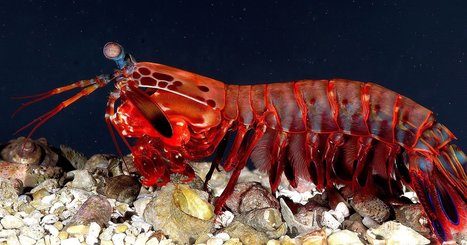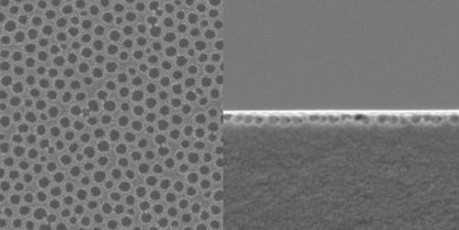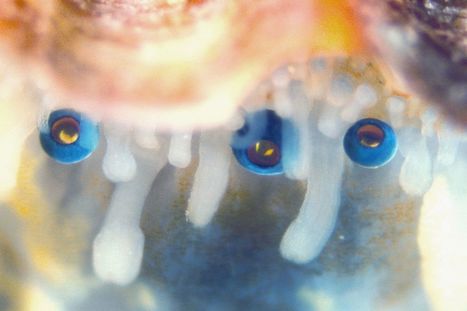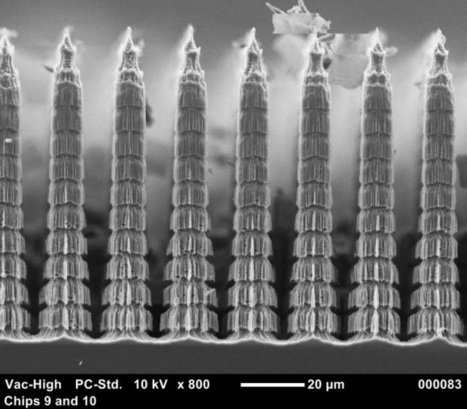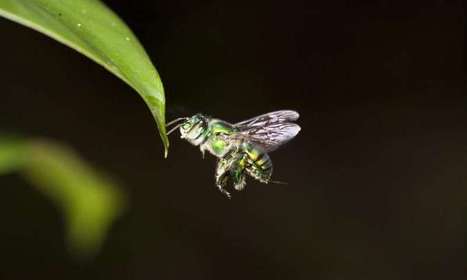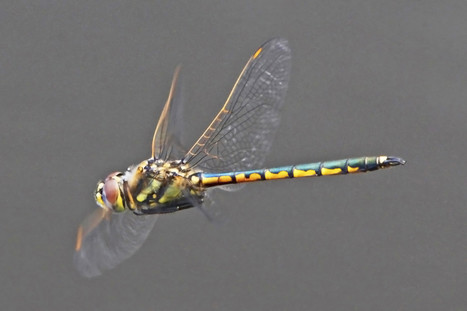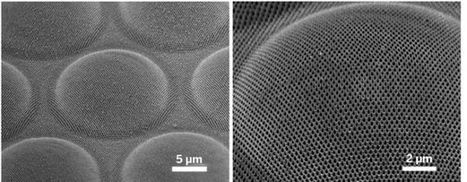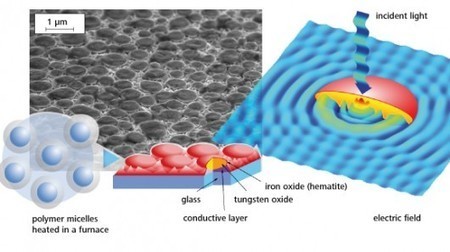 Your new post is loading...
 Your new post is loading...
"Researchers from the University of Illinois have managed to create a new camera called the Mantis Cam that can see polarized light. This technology provides possible solutions for everything from unlocking the mysteries of the underwater world to early cancer detection. The research was published in the journal Optica and takes its inspiration from the mantis shrimp, a crustacean with an incredible visual system. Humans have 3 different types of color receptors, but the mantis shrimp has 16 different receptors alongside another 6 polarization channels. Animals in the underwater world use polarized light for “covert communication channels” as well as hunting and navigation."
"A novel optics system that mimics the structure of a lobster’s eyes would enable a conceptual Explorer-class mission to precisely locate, characterize, and alert other observatories to the source of gravitational waves, which are caused by some of the most powerful events in the universe. [...] the WFI, is equipped with the novel lobster-eye optics, which mimic the structure of the crustacean’s eyes. Lobster eyes are made up of long, narrow cells that each reflect a tiny amount of light from a given direction. This allows the light from a wide viewing area to be focused into a single image."
Screens on even the newest phones and tablets can be hard to read outside in bright sunlight. Inspired by the nanostructures found on moth eyes, researchers led by Shin-Tson Wu of the University of Central Florida have developed a new antireflection film that could keep people from having to run to the shade to look at their mobile devices. The antireflection film exhibits a surface reflection of just 0.23 percent, much lower than the surface reflection of usual phones of 4.4 percent.
Combining the best features of a lobster and an African fish, engineers have created an artificial eye that can see in the dark. And their fishy false eyes could help search-and-rescue robots or surgical scopes make dim surroundings seem bright as day.
"UCL researchers have developed a revolutionary new type of ‘smart’ window which could cut window-cleaning costs in tall buildings while reducing heating bills and boosting worker productivity. The windows use nature inspired nanostructures which mimic the eyes of moths to cut glare, save energy and clean themselves."
The atomic structure of a moth’s eye and lotus leaves have inspired scientists to create a new glass coating that could increase the efficiency of solar panels by up to six per cent. “While lotus leaves repel water and self-clean when it rains, a moth’s eyes are antireflective because of naturally covered tapered nanostructures where the refractive index gradually increases as light travels to the moth’s cornea,” said Tolga Aytug, member of ORNL’s Materials Chemistry Group. “Combined, these features provide truly game-changing ability to design coatings for specific properties and performance.”"
"PenTile® technology is biomimetic, meaning it is designed to compliment the complex mechanics of the eye-brain system. As a simple example of eye mechanics consider how the eye utilizes the color blue. The eye has cone receptors that sense color and brightness, and discern patterns. These cones are sensitive to different wavelengths of color—primarily red, green, and blue. The blue cones detect mostly color (chroma) information, while the red and green cones do most of the work resolving images by discerning luminance, edges, and structural details of images, as well as contributing to color vision. The red and green cones are used independently, each cone seeing a "dot" of black and white—ignoring its color to produce high resolution luminance perception—and are used in opposition, comparing the amount of red versus green, to produce low resolution color perception. The PenTile RGBW™ layout uses each red, green, blue and white subpixel to present high-resolution luminance information to the red and green cones, while using the combined effect of all the color subpixels to present lower-resolution chroma (color) information to all three cone types. Combined, this optimizes the match of display technology to the biological mechanisms of human vision." Photo details: Brown eyes, 2007 by Alecgarci 149. Licensed under Public Domain via Wikimedia Commons.
"Shrimps' eyes have been revealed as the latest weapon against cancer, with their unique vision set to be adapted to diagnostic cameras. University of Queensland research has found the shrimps' compound eyes were able to detect polarised light, which could be mimicked to detect cancer cells."
"Moth eyeballs are made up of tiny cones that reduce glare. UC Irvine researchers copied the pattern on a new, flexible material and coated it with a bit of gold to make a product that could improve solar panels, LED displays and disguising of weapons."
"Nature’s inventiveness often inspires human innovation as in the well-known case of hook-and-loop fasteners: Swiss engineer George de Mestrel turned a hiking annoyance (burrs) into a handy tool (Velcro). But did you know that safety road markers were inspired by a cat’s eyes reflecting headlights. [...] “Eyeshine” may be most familiar as a feline phenomenon, but it occurs in a tremendous variety of animals, from moths to whales. It’s caused by the tapetum lucidum, a reflective layer behind the photosensitive part of the eye which bounces photons back, giving them a second chance to be seen. This ability is a major advantage at night and in the deep sea and has evolved many times in many different forms."
"The retina is an enormously powerful tool. It sorts through massive amounts of data while operating on only a fraction of the power that a conventional digital camera and computer would require to do the same task. Now, engineers at a company called iniLabs in Switzerland are applying lessons from biology in an effort to build a more efficient digital camera inspired by the human retina."
Moth eyes have evolved to cut out light reflection so that it can see well at night. Scientists have created a nanofilm that mimicks the moth's eye to enhance solar cell efficiency.
The blind cavefish has a problem. In the absolute blackness where it lives, no light illuminates its world. Yet the small fish has traded its eyesight for a different way to perceive its environment: "touch at a distance."
|
Scallops, hardly the most complex of creatures, have intricate eyes that work like telescopes, say researchers. They hope this discovery can one day help us make our own telescopes more powerful.
Scientists at the USA’s Stanford University have looked at the eyes of insects to create the newest form of solar cells. They have discovered that packing tiny solar cells together could pave the way for a new generation of advanced photovoltaics.
"If you wanted to see in the dark, you could do worse than follow the example of moths, which have of course made something of a specialty of it. That, at least, is what NASA researchers did when designing a powerful new camera that will capture the faintest features in the galaxy."
"After studying how insects navigate through dense vegetation, researchers at Lund University in Sweden have come up with a system that can be applied to flying robots. By adapting the system to drones, they can be made to adjust their speed to their surroundings and fly on their own- completely without human intervention and control. The breakthrough was made by vision researchers Emily Baird and Marie Dacke at the Department of Biology in Lund. Among other things, their research shows how bees that fly through dense forests assess light intensity to avoid other objects and find holes in the vegetation to enable them to navigate safely."
"Researchers have developed an artificial-intelligence system based on a dragonfly’s vision that they say could aid the blind and help create a better driverless car. [...] In the latest research, published in the Journal of the Royal Society Interface, scientists showed how a computer program can mimic the eyesight of a dragonfly. Compared with humans, dragonflies have a limited ability to distinguish details and shapes of objects. But they are one of the insect kingdom’s best predators because their wide field of vision and ability to detect fast movements allow them to keep track of prey even among a swarm of insects."
"The eyes of nocturnal moths contain a series compound lenses: micro lenses called ommatidia which are themselves patterned with a nanoscale dome-shaped bumps. These structures naturally help reduce reflection of light at a wide range of wavelengths, enabling better night vision to help moths navigate in the dark. [...] The ability to capture light and not let go is appealing in the world of solar cells because it can increase efficiency. So the team from Singapore has taken inspiration from the complex lens structure to create a process that stamps patterns over the surface of a material, replicating the antireflective effects of the moths' eyes. "
"Nano-imprint technology, a technique in which microscopic indentations are made on an object's surface, is changing the nature of various products, including TV screens, semiconductors and tissue cultures. One application already being used is in making so-called moth-eye film, a transparent film developed by Dai Nippon Printing that reflects almost no light. This film is modeled after a moth's eyes, which are known for reflecting little to no light, allowing the insect to better hide from predators. This is achieved by minute bumps that are around 200 nanometers, 200 billionths of a meter, in diameter. Nano-imprint technology helped researchers create such surfaces on film."
"As nocturnal creatures, moths need to maximize how well they can see in the dark whilst remaining less visible to avoid predators. This ability to collect as much of the available light as possible and at the same time reflect as little as possible, has inspired Researchers at the Swiss Federal Laboratories for Materials Science and Technology (Empa) to design a new type of photoelectrochemical cell using relatively low cost materials."
"Entomologists study insects known for their hard exoskeletons, jointed appendages, segmented bodies, bilateral symmetry and antennae. But perhaps the most impressive part of an insect is its lateral compound eyes. Scientists wishing to study insects have over 1 million species to select from! Insect eyes are so impressive scientist and researcher John Rogers of the Science Research Group at Urbana-Champaign, University of Illinois, is designing miniature drones cameras based on their unique design. The big challenge for engineers is to build a drone camera with a 180° range of vision and clear vision throughout that line of sight. Insects have this ability when born."
"One example of biomimicry that keeps popping up on the pages of Gizmag is the use of insect eyes as a model for innovative new optical devices. It seems that the potential for development in this area is far from exhausted with the announcement of another bug-inspired lens breakthrough from Ohio State University. This experimental lens developed by associate professor of biomedical engineering and ophthalmology, Yi Zhao, combines the wide angle properties of insect vision with the depth-of-field capabilities of a human eye."
Humans see the world through a pair of high resolution, single lens eyes that allow us to adjust focus and pinpoint fine details. But simpler creatures, like insects, instead rely on compound eyes that have lower resolution but offer a much wider distortion-free field-of-view that's actually better suited for lightning fast motion perception. And as researchers work towards designing autonomous drones that will behave like futuristic artificial bugs, it's only fitting that they also work to replicate how an insect sees.
"Inspired by the complex fly eye, an interdisciplinary team led by researchers at the University of Illinois at Urbana-Champaign and Northwestern University has developed a hemispherical digital camera with nearly 200 tiny lenses, delivering exceptionally wide-angle field of view and sharp images."
|
 Your new post is loading...
Your new post is loading...
 Your new post is loading...
Your new post is loading...





